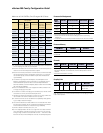64
goals, WLM can adjust processor capacity, channel paths,
and I/O requests across LPARs without human intervention.
IRD assigns resources to the application; the applica-
tion is not assigned to the resource. This capability of a
system to dynamically direct resources to respond to the
needs of individual components within the system is an
evolutionary step. It enables the system to continuously
allocate resources for different applications, and this helps
to reduce the total cost of ownership of the system. IRD is
made up of three parts that work together to help optimize
the utilization of zSeries resources:
• LPAR CPU Management
• Dynamic Channel Path Management
• Channel Subsystem Priority Queuing
The z/OS Intelligent Resource Director (IRD) Planning
Wizard helps to plan your IRD implementation by asking
questions about your enterprise setup, and produces a
worksheet that describes the issues on each of your systems
that you must consider before you can implement IRD. The
z/OS IRD Planning Wizard supports z/OS 1.2 and higher.
zSeries Application Assist Processor
The IBM ^ zSeries Application Assist Processor
(zAAP), available on the z990 and z890 servers, is an
attractively priced specialized processing unit that pro-
vides an economical Java execution environment for z/OS
for customers who desire the traditional qualities of service
and the integration advantages of the zSeries platform.
When confi gured with general purpose processors within
logical partitions running z/OS, zAAPs may help increase
general purpose processor productivity and may contrib-
ute to lowering the overall cost of computing for z/OS Java
technology-based applications. zAAPs are designed to
operate asynchronously with the general processors to
execute Java programming under control of the IBM Java
Virtual Machine (JVM). This can help reduce the demands
and capacity requirements on general purpose proces-
sors which may then be available for reallocation to other
zSeries workloads.
The IBM JVM processing cycles can be executed on the
confi gured zAAPs with no anticipated modifi cations to
the Java application(s). Execution of the JVM processing
cycles on a zAAP is a function of the Software Developer’s
Kit (SDK) 1.4.1 for zSeries, z/OS 1.6, and the Processor
Resource/Systems Manager (PR/SM).
z/OS Scalability
z/OS is a highly scalable operating system that can sup-
port the integration of new applications with existing
mainframe applications and data. z/OS can scale up in a
single logical partition, or scale out in a Parallel Sysplex for
higher availability. With z/OS V1.6, up to 24 processors are
supported in a single logical partition on the z990 server.
In previous releases, z/OS supported up to 16 processors.
In a Parallel Sysplex, up to 32 z/OS images can be confi g-
ured in single-image cluster, with access to shared data.
64-bit Support
z/OS scale is extended with support for 64-bit real and
virtual storage on zSeries servers, while continuing to sup-
port 24-bit and 31-bit applications.
The 64-bit real support is intended to eliminate expanded
storage, helps eliminate paging and may allow you to
consolidate your current systems into fewer LPARs or to
a single native image. z/OS 1.5 delivers 64-bit shared
memory support to allow middleware to share large
amounts of 64-bit virtual storage among multiple address
spaces. This is expected to provide a signifi cant capacity
enhancement for relieving shared virtual storage constraints.


















